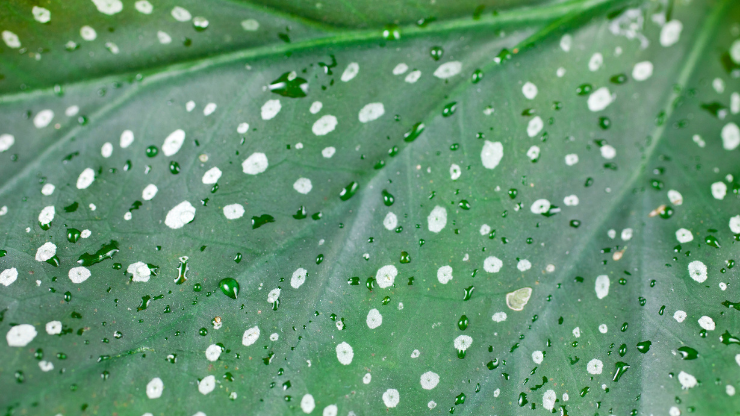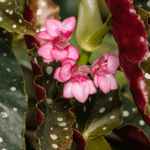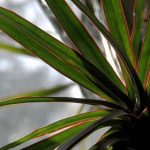
Begonia corallina (angel wing begonia) is the best type of begonia to grow as a houseplant. With beautiful wing-shaped, spotted leaves and elegant flower clusters, it makes a gorgeous display in any room – provided there’s enough light. Dozens of species and cultivars are available, and they vary in size, leaf pattern, and flower color.
Dwarf angel wing begonia cultivars may only reach 12 inches (30 cm) in height, while larger ones become shrub-like and reach more than 36 inches (90 cm) tall and wide. Bloom time also varies, but most cultivars flower best in late winter or early spring. Some varieties bloom year-round with proper care. Flowers may be red, pink, or white.
In this post, I’ll cover all aspects of Begonia corallina care (as a houseplant) – including how to keep this beautiful bloomer producing flowers for years in your home.
Begonia Corallina Care Guidelines
For blooming houseplants, angel wing begonias are relatively easy to grow. They don’t have extreme moisture requirements, but they do need a lot of bright, indirect light to produce flowers. Here’s a brief run-down of Begonia corallina care guidelines:
- WATER: When top 1 inch (2.5 cm) of soil dries out
- HUMIDITY: Moderate
- FEEDING: Every two weeks with diluted high-phosphorus fertilizer
- LIGHT: Bright, filtered light, with increased brightness during winter
- TEMPERATURE: 65 – 75 degrees F (18 – 24 degrees C)
- SAFETY: Toxic to cats, dogs, and humans
- DIFFICULTY: Moderately Easy
Keep reading for more in-depth information on caring for your angel wing begonia houseplant, including propagation, maintenance, and troubleshooting.
Water
Another important aspect of Begonia corallina care is watering frequency. Allow the soil to dry out to a depth of 1 inch (2.5 cm) between waterings. To test soil moisture, insert your finger into the soil up to the first knuckle. If the soil feels dry, water thoroughly. If the soil still feels moist, check again the next day.
Humidity
Begonia corallina needs moderate humidity levels. Increase humidity near the plant by misting several times a week with a spray bottle of lukewarm water set to the mist setting, or place the plant on a homemade humidity tray.
If you live in a very dry climate or your home is centrally heated, consider placing a high-quality humidifier in the room near your begonia. I live in the desert and love to grow tropical plants, so I use the Honeywell Coolmist Humidifier to keep my plants thriving.
Fertilizer
Feed your Begonia corallina plants once every two weeks using a high-phosphorus houseplant fertilizer diluted to half strength during the growing season. High-phosphorus means the second number is higher than the other two, such as 10-30-20.
My favorite fertilizer for indoor flowering plants is Jack’s Blossom Booster but any houseplant fertilizer with higher phosphorus levels will work fine. High phosphorus fertilizer promotes flower production and brighter colors.

Light
In spring and summer, angel wing begonias need bright, filtered light with no direct sun. An ideal location is an east-facing window with the light filtered by sheer curtains. They also grow well under artificial plant lights for 14 – 16 hours per day. These begonias cannot tolerate direct sun.
In the winter, they benefit from increased brightness and perform best near a south- or west-facing window with the light filtered by sheer curtains. They also grow well under artificial plant lights for up to 18 hours per day during winter.
Temperature
Begonia corallina prefers average room temperatures of 65 – 75 degrees F (18 – 24 degrees C) year-round. They can tolerate temperatures as low as 60 degrees F (15 degrees C) and as high as 80 degrees F (26 degrees C), but only for short periods.
Angel wing begonias are easily damaged by temperatures below 55 degrees F (12 degrees C), so make sure to protect them from cold drafts.
Potting
The best potting mix for Begonia corallina is a light soil-less mix amended with peat moss, such as an African violet potting mix. I use this mix by Black Gold for my indoor flowering plants, and I’ve had very good results. But any good potting mix formulated for African violets will work.
Re-pot angel wing begonia annually in spring, shifting to a slightly larger container (no more than 2 inches larger than the previous one). Angel wing begonias have fibrous roots and grow best in smaller pots. Add some broken crockery or pebbles to the bottom of the pot to increase weight and improve drainage.
Begonia Corallina Propagation
The best way to propagate Begonia corallina is by taking stem cuttings. In late spring or early summer, root non-flowering stem cuttings in moist seed-starting mix following these instructions:
- Using clean pruning shears, cut a 4-inch (10-cm) piece of stem from a healthy area of the parent plant at a 45-degree angle.
- Remove leaves from the lower one-third of the cutting. Dip the cut end into a rooting hormone powder, and tap to remove any excess.
- Insert the bottom one-third of the cutting into moist seed starting potting mix.
- Cover with plastic and place in indirect light. Keep the potting mix moist, and transplant into regular potting soil after 4 – 6 weeks.
Maintenance
Begonia corallina has needs very little maintenance. You may need to clean its leaves with a damp cloth once every few weeks to keep them free of dust. Snip off any dead or dying leaves at the base of the stem and remove spent flowers using clean pruning shears, when needed.
Begonia Corallina Varieties
There are many different varieties of angel wing begonias out there, but here are some of the most popular on the market right now:
- ‘Pink Mink’ – Has dark, almost black leaves with bright pink spots; gorgeous foliage.
- ‘Medora’– Small-leaved angelwing, but a prolific bloomer with rosy pink blossoms; leaves are dark green with white spots.
- ‘Frosty’ – Leaves are medium-green with highly speckled with white; grown more for foliage than flowers.
- ‘Fanny Moser’ – Popular angelwing begonia with beautiful foliage; dark, almost black leaves with white spots.
- ‘Lucerna’ – One of my favorites, it produces hanging clusters of delicate pink flowers; foliage is the traditional wing-shaped leaves with silver-metallic specks.
- ‘My Special Angel’ – Striking dark green leaves with white spots and beautiful pink blossoms; semi-trailing so works great in a hanging basket.
Other varieties of note include ‘Looking Glass,’ ‘Avalanche,’ ‘Torch Pink,’ ‘Cracked Ice,’ ‘Sophia,’ ‘Sinbad,’ ‘Morocco,’ and ‘Lana.’

Troubleshooting
Here are some common problems indoor gardeners may have when growing angel wing begonias indoors (and how to fix them).
- Leaves Turn Yellow or Brown – If your Begonia corallina leaves are turning yellow or brown, this usually means it’s being over-watered. Water only when the top 1-inch of soil feels dry tot the touch. Cool conditions and over-sized pots can contribute to over-watering, so grow in small pots and keep the temperature above 65 degrees F (18 degrees C).
- Pale or Brittle Leaves – If leaves become pale or brittle, this usually means your begonia is receiving too much light or the air is too dry. Avoid direct sunlight. Grow in an east-facing window during spring and summer, and a west- or south-facing window with light filtered by sheer curtains in fall and winter. Increase humidity by misting, placing the plant on a humidity tray, or placing near a humidifier.
Related Questions
Here are some frequently asked questions related to Begonia corallina care that you might find helpful (and my answers to them).
How Do You Prune Begonia Corallina? Angel wing begonias don’t require pruning aside from removing any dead or damaged leaves. But if you have a leggy plant or want to make it bushier/more compact, you can prune it back. Use clean scissors or pruning shears to cut stems back to a leaf node (where the leaf joins the stem). Don’t prune more than 3 – 5 inches from the soil. Your plant should send up lots of new growth soon.
How Long Do Potted Begonias Last? This depends on the variety and the care it receives. Begonia corallina can live up to five years with proper care. Most varieties live several years, but you can keep them going indefinitely by propagating from stem cuttings (see propagation section above for more information).
Related: Why is My Angel Wing Begonia Dying?
Where to Buy Begonia Corallina
Begonia corallina is a popular flowering houseplant, and depending on your location, you may be able to find it for sale in local nurseries or big box stores with garden centers – like Walmart or Lowe’s. It never hurts to call around and ask.
If you can’t find one locally, I recommend check the current listings on Etsy. I always buy my exotic or hard-to-find houseplants from small growers on Etsy. I like to support small businesses, and I’ve found that they seem to care much more about the quality of their plants than large corporate nurseries.
Click here to see the current listings for Begonia corallina on Etsy. You may even find some rare cultivars for sale there too. Good luck and happy growing!




